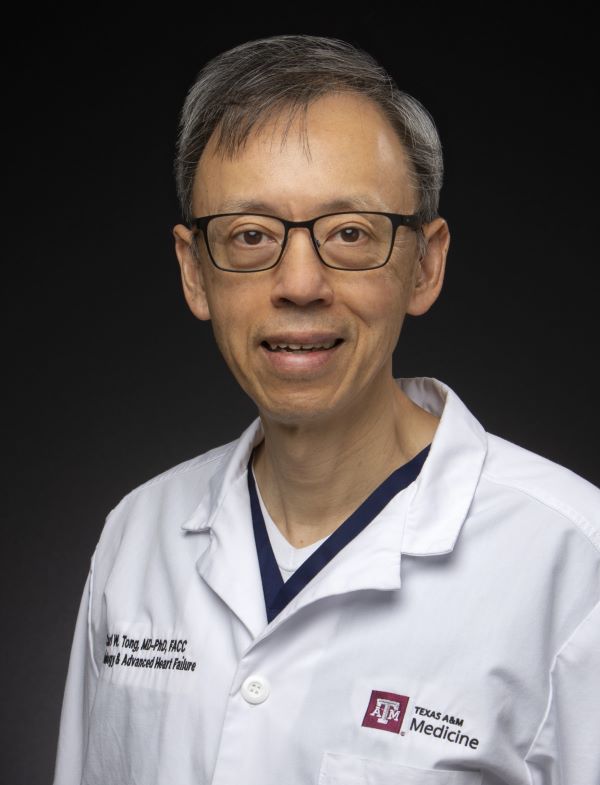Carl Tong, MD, PhD, FACC

Associate Professor, Medical Physiology
Director, Division of Cardiac Biology
Contractile Proteins; Diastolic Dysfunction; Contractility; Cardiomyopathy; Calcium to Cross-Bridge Relationship
Contact
Medical Physiology
8447 John Sharp Pkwy
2346 Medical Research and Education Building 2
Bryan,
TX
77087
ctong@tamu.edu
Phone: tel:979-776-8440
Education and Training
- Texas A&M University, BS, Electrical Engineering, 1985
- Air Force Institute of Technology, MS, Electrical Engineering, 1986
- Texas A&M University Naresh K. Vashisht College of Medicine, MD/PhD, Medical Physiology, 2002
- Duke University Medical Center, Internal Medicine Residency, 2005
- University of Wisconsin, Cardiology Fellowship, 2010
Professional Certifications
- Advanced Heart Failure and Transplant Cardiology, Active
- Cardiovascular Disease, Active
Research Interests
- Since 1921, heart disease has remained the No. 1 cause of death in the United States. Alarmingly, after declining heart disease death rates from 1980 to 2005, the number of heart disease deaths has steadily risen from 2010 to present. Heart failure, which is a subset of heart disease, occurs when the heart cannot provide sufficient blood flow to the body. Since 1971, approximately 50% of heart failure patients die within five years despite many medical advances. Heart failure affects 6.2 million Americans. Prevalence of heart failure is projected to increase to greater than 8 million Americans by 2030. Heart failure is a progressive disease that incapacitates its victims over time until death. As a practicing cardiologist, Tong sees how his patients and their families suffer from heart failure. The suffering of his patients strongly motivates him to conduct research that can bring about better treatments in the future.
- A complex system of multistep processes produces contraction and relaxation of the heart with each beat. An electrical impulse causes calcium release within the heart cells. Subsequently, the increasing calcium concentration triggers myosin attachment to actin (i.e., cross-bridge attachment). Cross-bridges reside within the fundamental contraction unit of the heart muscle called the sarcomere. The attached cross-bridge converts stored chemical energy to mechanical force to form the basis for contraction. The active processes of energy restoration, calcium removal, cross-bridge detachment, and inactivation of the sarcomere form the basis for relaxation of the heart. The heart requires appropriate relaxation rate to allow sufficient refilling before the next beat. Thus, any mechanism that disturbs cross-bridge attachment/detachment processes will result in eventual heart failure. With this in mind, Tong's laboratory focuses on elucidating mechanisms that can improve cross-bridge attachment/detachment processes as potential future treatments for heart failure.
- Cardiac Myosin Binding Protein-C (cMyBP-C) is a protein that exists within the thick filament in the sarcomere. Tong hypothesizes that phosphorylation of cMyBP-C improves rates of both cross-bridge attachment and detachment, thereby improving heart function. Consequently, his team endeavors to demonstrate and translate effects of cMyBP-C phosphorylation toward new treatments for heart failure.
- cMyBP-C is released into the circulation with both physiological and pathological stress. Tong hypothesizes that serum cMyBP-C levels can screen for existence of severe cardiovascular diseases and guide therapy. Thus, his team aims to demonstrate that following cMyBP-C release can be helpful in prevention and treatment settings.
- Although excellent for elucidating basic mechanisms, Tong believes that mouse models cannot fully represent the human heart. Consequently, representative human heart tissue is needed for development of new therapies. In this context, his team also aims to mature 3-D engineered heart tissue that are derived from human induced pluripotent stem cells into a reliable test platform.
Representative Publications
Lab Members
Laticia Ellankil
Student Research Assistant
Research Group: Dr. Carl Tong
laticiaellankil123@tamu.edu
Malak Ezzat
Student Research Assistant
Research Group: Dr. Carl Tong
malak_ezzat@exchange.tamu.edu
Eric Hall
Non-Affiliated Student Assistant
Research Group: Dr. Carl Tong
ehall@tamu.edu
Student Research Assistant
Research Group: Dr. Carl Tong
yunwookwon@tamu.edu
Student Research Assistant
Research Group: Dr. Carl Tong
ryanm@tamu.edu
Student Research Assistant
Research Group: Dr. Carl Tong
vnandakumar@tamu.edu
Student Research Assistant
Research Group: Dr. Carl Tong
hannah.ngai@tamu.edu
Student Research Assistant
Research Group: Dr. Carl Tong
spozonavarro@tamu.edu
Student Research Assistant
Research Group: Dr. Carl Tong
cedric.robinson@tamu.edu
Student Research Assistant
Research Group: Dr. Carl Tong
aishusenthil@tamu.edu
Student Research Assistant
Research Group: Dr. Carl Tong
tugwekat@tamu.edu